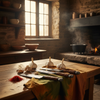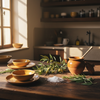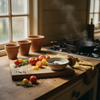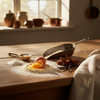The Home Chefs Cooking Spatula Handbook 2025
Key Takeaways
- A cooking spatula is an essential tool for home chefs aiming to improve their cooking experience.
- Using the wrong spatula can lead to frustrating cooking results, like damaged pancakes or melted utensils.
- Selecting the right heat-resistant and durable spatula is crucial for successful cooking.
- The handbook aims to help home chefs choose the perfect spatula to enhance their kitchen skills.
Table of Contents
- What is a Cooking Spatula? The Kitchen's Most Versatile Tool
- Cooking Spatula Types, Find Your Culinary Match
- How to Choose the Best Spatula for Every Task
- Spatula Showdown: Comparing Styles, Materials, and Use Cases
- Mastering Technique: Using Your Spatula Like a Pro
- Maintenance and Care for Lifelong Performance
The Home Chef's Cooking Spatula Handbook 2025
Your perfect pancake just folded like a wet napkin. Again. Or maybe you watched in horror as your "heat-resistant" spatula melted into your scrambled eggs. We've all been there, and it's not your technique, it's your tool. A seamless long spatula can make all the difference in these frustrating moments.
A cooking spatula is the unsung hero of every kitchen victory, from flipping delicate fish fillets to scraping every last bit of brownie batter. But not all spatulas are created equal. The right one transforms kitchen frustrations into culinary confidence, while the wrong one leaves you with melted plastic in your food and scratched pans. If you're looking to upgrade, this seamless long spatula is designed for both durability and versatility.
This handbook cuts through the confusion with tested insights, material science, and real-world applications. Whether you're tackling your first soufflé or perfecting your holiday roast, you'll discover exactly which spatula delivers the performance, safety, and durability your culinary creativity deserves.
What is a Cooking Spatula? The Kitchen's Most Versatile Tool
A cooking spatula is more than just a flipper, it's the multitasking MVP of your kitchen. Whether you're flipping, scraping, stirring, or spreading, the right spatula can make every culinary adventure smoother and more enjoyable. From breakfast pancakes to late-night brownies, spatulas are the unsung heroes behind every delicious bite.
Cooking Spatula Types, Find Your Culinary Match

Every spatula serves a purpose, but choosing the wrong type for your task is like using a butter knife to carve a roast. Here's your decoder guide to spatula specialization.
Turner Spatulas (The Workhorses)
Best for: Flipping pancakes, burgers, eggs, and grilled vegetables. Standard turners feature solid blades perfect for supporting delicate foods, while slotted versions drain excess oil or liquid. Fish spatulas, with their ultra-thin, flexible blades, excel at sliding under fragile fillets without breaking them apart.
Pro tip: Look for slightly beveled edges that create a natural wedge for easy food release.
Scraper Spatulas (The Efficiency Experts)
Best for: Folding batters, scraping bowls clean, and stirring sauces. These flexible-blade champions, often called silicone spatulas, conform to container curves and withstand high heat without melting or transferring flavors.
Pro tip: Choose seamless construction to prevent bacteria buildup in crevices where blade meets handle.
Offset Spatulas (The Precision Artists)
Best for: Frosting cakes, spreading batters evenly, and lifting delicate baked goods. The angled blade keeps your knuckles clear of surfaces while providing superior control for detailed work.
Material Reality Check: Silicone handles heat up to 600°F and won't scratch nonstick surfaces. Metal excels for heavy-duty flipping but can damage coated pans. Wood offers gentle strength but requires more maintenance. Plastic? Only if it's BPA-free and rated for your cooking temperatures.
How to Choose the Best Spatula for Every Task
Matching your spatula to your cookware isn't just preference, it's performance science. Use the wrong combination, and you'll scratch expensive pans or worse, introduce harmful chemicals into your food.
Match Your Cookware
Nonstick surfaces demand silicone spatulas or wood to preserve their coating. Cast iron and stainless steel can handle metal spatulas that provide the strength needed for heavy foods. Carbon steel falls somewhere between, silicone works best, but well-seasoned surfaces can tolerate careful metal use.
Temperature matters more than most home chefs realize. Standard plastic spatulas fail around 200°F, while pro-grade silicone like DI ORO's seamless series maintains integrity up to 600°F, hot enough for any stovetop or oven application.
Task-Specific Selection
For flipping eggs, choose thin, flexible edges that slide easily under delicate proteins. Stirring thick sauces requires wider, sturdy blades that won't bend under pressure. Baking applications need offset designs for precise spreading and lifting.
Handle length impacts control and safety. Eight-inch handles work for most stovetop tasks, while 12+ inch handles keep hands safely away from grill heat.
The award-winning DI ORO Seamless Series, recognized by America's Test Kitchen as the "Best All-Purpose Silicone Spatula," features a 13-inch ergonomic handle with pro-grade silicone construction that remains cool and comfortable during extended cooking sessions.
Flexibility & Strength
The perfect cooking spatula balances flexibility for delicate tasks with strength for heavy-duty work. Fish spatulas excel with their thin, flexible blades that slide effortlessly under delicate fillets, while rigid metal spatulas provide the backbone needed for smashing burgers or lifting dense casserole portions.
DI ORO's seamless design incorporates a stainless steel core wrapped in pro-grade silicone, delivering precision control without the bend-and-break failures common in cheaper alternatives. This engineering prevents the frustrating flex that causes dropped food and kitchen accidents.
Joint & Seam Construction
Single-piece construction eliminates the weak points where handles separate from blades, a common failure in multi-part spatulas. Seamless designs prevent bacteria buildup in crevices and ensure your spatula won't fall apart mid-flip during your holiday dinner.
Traditional spatulas with visible joints create food safety risks and cleaning headaches. DI ORO's seamless silicone spatulas eliminate these concerns entirely, offering restaurant-grade durability with home kitchen convenience.
For more on the different types of spatulas and their uses, see this in-depth guide to spatulas.
Spatula Showdown: Comparing Styles, Materials, and Use Cases
The right cooking spatula transforms kitchen chaos into culinary confidence. Understanding how different materials and designs perform across various cooking scenarios helps you build a toolkit that handles everything from delicate fish fillets to thick pancake batter.
| Feature | Silicone | Metal | Wood | Plastic |
|---|---|---|---|---|
| Max Temperature | 600°F (pro-grade) | 800°F+ | 400°F | 200-300°F |
| Nonstick Safe | Yes | No | Yes | Yes |
| Dishwasher Safe | Yes | Yes | No | Usually |
| Flexibility | Perfect balance | Rigid | Moderate | Too flexible |
| Chemical Safety | Forever-chemical free (quality brands) | Inert | Natural | Potential BPA concerns |
Silicone emerges as the clear winner for versatility. Pro-grade silicone spatulas like DI ORO's seamless series combine the heat resistance needed for high-temperature cooking with the gentleness required for delicate nonstick surfaces. The stainless steel core prevents bending while maintaining the flexibility essential for effective scraping and flipping. For a closer look at the benefits of a flexible spatula for cooking and baking, check out this expert guide.
Metal spatulas excel in specific scenarios, smashing burgers, lifting heavy lasagna portions, or working with cast iron cookware. However, their rigidity and potential to scratch limits their versatility. Wood offers natural antimicrobial properties and gentle handling but requires hand-washing and regular oiling to prevent cracking.
Turner vs. Scraper vs. Offset: Choosing Your Weapon
Turner spatulas feature thin, angled edges designed for sliding under foods. Fish turners take this further with perforated, ultra-thin profiles that minimize contact area. Standard turners work best for pancakes, eggs, and burgers where you need clean release without breaking.
Scraper spatulas prioritize flexible edges that conform to bowl curves. These workhorses excel at batter mixing, sauce stirring, and ensuring zero waste when transferring ingredients. The seamless construction prevents bacteria buildup in crevices where traditional spatulas fail.
Offset spatulas angle the blade below the handle, creating clearance for spreading and lifting. Bakers rely on these for frosting cakes and transferring delicate cookies. The offset design keeps knuckles clear of surfaces while maintaining precise control.
For more on the versatility of turner spatulas, read this detailed article on turner spatulas.
Mastering Technique: Using Your Spatula Like a Pro

Proper spatula technique separates confident home chefs from frustrated beginners. The difference between perfectly flipped pancakes and torn disasters often comes down to timing, angle, and tool selection.
The Perfect Flip: Timing and Execution
Master the three-second flip method: slide the spatula completely under the food, lift decisively, flip with a quick wrist motion, and lower gently. Hesitation creates tears and uneven cooking. Watch for visual cues, pancakes should bubble around edges with set centers before attempting the flip.
For delicate fish, use the "confidence slide" technique. Insert the spatula at a 15-degree angle, pushing gently to ensure complete support before lifting. The thin, flexible edge of a quality silicone spatula conforms to the pan surface, sliding under without catching or tearing.
Scraping Without Waste: The Professional Approach
Effective scraping requires understanding bowl geometry. Hold the spatula at a 45-degree angle to the bowl wall, maintaining constant contact while rotating the bowl with your free hand. This technique ensures complete ingredient incorporation without overworking batters.
For sauce stirring, use figure-eight motions rather than circular stirring. This pattern prevents lumps while incorporating ingredients evenly. The flexible edge should bend slightly against the pan bottom, indicating proper pressure without excessive force that could damage nonstick coatings.
Spreading and Frosting Like a Bakery Pro
Smooth frosting application starts with proper spatula loading. Apply frosting to the center of your surface, then use long, continuous strokes working outward. Keep the spatula at a consistent angle, approximately 30 degrees to the surface, for even distribution.
For professional-looking edges, use the "hot spatula trick." Dip your clean spatula in warm water, dry quickly, and make final smoothing passes. The slight warmth helps frosting flow while creating that coveted bakery-smooth finish.
For a curated list of the best cooking utensils to complement your spatula skills, check out this resource.
Maintenance and Care for Lifelong Performance
Proper maintenance extends spatula life while ensuring food safety. Different materials require specific care approaches, but consistent cleaning and storage practices prevent common problems like odor retention, staining, and premature wear.
Material-Specific Cleaning
Silicone: Dishwasher safe and resistant to stains and odors. For stubborn residue, soak in warm soapy water and use a soft sponge. Avoid abrasive cleaners to preserve the nonstick surface.
Metal: Most metal spatulas are dishwasher safe, but hand washing preserves finish and prevents rust. Dry thoroughly before storing.
Wood: Hand wash only. Avoid soaking, as water can cause warping or cracking. Periodically treat with food-safe mineral oil to maintain luster and prevent drying.
Plastic: Check for dishwasher compatibility. Avoid high heat and inspect regularly for signs of melting or warping.
Storage Tips
Store spatulas in a utensil holder or drawer organizer to prevent bending or damage. Avoid placing heavy items on top of silicone or plastic spatulas to maintain their shape. For longevity, keep wooden spatulas in a dry, well-ventilated area.
When to Replace Your Spatula
Replace your spatula if you notice cracks, warping, or persistent odors that don't wash out. Damaged spatulas can harbor bacteria or introduce unwanted flavors to your food. Investing in high-quality, seamless designs like DI ORO's ensures your spatula will last for years of culinary adventures.
When selecting a cooking spatula, it's important to consider chemical safety and material science. For an authoritative overview of silicone safety in kitchen tools, see this analysis of the pros and cons of silicone.
Concerns about chemical exposure from certain plastics and coatings are valid. For more on the risks associated with perfluorooctanoic acid (PFOA) in cookware, refer to this resource from the National Cancer Institute.
Frequently Asked Questions
What are the different types of cooking spatulas and what tasks are they best suited for?
Turner spatulas are the workhorses, ideal for flipping pancakes, burgers, eggs, and grilled veggies, with slotted versions that drain excess oil. Fish spatulas have thin, flexible blades perfect for delicate fillets, while silicone spatulas excel at scraping, stirring, and folding batter without scratching cookware.
How do I choose a heat-resistant and durable spatula that won't damage my cookware?
Look for spatulas made with pro-grade silicone that can withstand high temperatures (up to 600°F) without melting or warping. Choose tools with flexible, thin edges for delicate tasks and sturdy handles for durability, ensuring they’re safe for non-stick and other sensitive surfaces.
Why is seamless construction important in a silicone spatula, and how does it affect hygiene?
Seamless construction eliminates crevices where food and bacteria can hide, making the spatula easier to clean and more hygienic. This design also enhances durability by preventing cracks and breaks, ensuring your spatula lasts through countless cooking adventures.
What materials are recommended for cooking spatulas to ensure safety and effectiveness in the kitchen?
Pro-grade silicone is the top choice for safety and performance, it's heat-resistant, flexible, and free of forever chemicals. Nylon is another option but may have lower heat tolerance. Avoid spatulas with harmful coatings or materials that can melt or leach into food.



